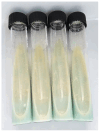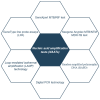Evolution of Laboratory Diagnosis of Tuberculosis
- PMID: 38525709
- PMCID: PMC10961697
- DOI: 10.3390/clinpract14020030
Evolution of Laboratory Diagnosis of Tuberculosis
Abstract
Tuberculosis (TB) is an infectious disease of global public health importance caused by the Mycobacterium tuberculosis complex. Despite advances in diagnosis and treatment, this disease has worsened with the emergence of multidrug-resistant strains of tuberculosis. We aim to present and review the history, progress, and future directions in the diagnosis of tuberculosis by evaluating the current methods of laboratory diagnosis of tuberculosis, with a special emphasis on microscopic examination and cultivation on solid and liquid media, as well as an approach to molecular assays. The microscopic method, although widely used, has its limitations, and the use and evaluation of other techniques are essential for a complete and accurate diagnosis. Bacterial cultures, both in solid and liquid media, are essential methods in the diagnosis of TB. Culture on a solid medium provides specificity and accuracy, while culture on a liquid medium brings rapidity and increased sensitivity. Molecular tests such as LPA and Xpert MTB/RIF have been found to offer significant benefits in the rapid and accurate diagnosis of TB, including drug-resistant forms. These tests allow the identification of resistance mutations and provide essential information for choosing the right treatment. We conclude that combined diagnostic methods, using several techniques and approaches, provide the best result in the laboratory diagnosis of TB. Improving the quality and accessibility of tests, as well as the implementation of advanced technologies, is essential to help improve the sensitivity, efficiency, and accuracy of TB diagnosis.
Keywords: diagnosis; laboratory; tuberculosis.
Conflict of interest statement
The authors declare no conflicts of interest.
Figures





References
-
- World Health Organization Global Tuberculosis Report 2022. [(accessed on 10 August 2023)]. Available online: https://www.who.int/teams/global-tuberculosis-programme/tb-reports/globa....
-
- Aghajani J., Farnia P., Farnia P., Ghanavi J., Saif S., Marjani M., Tabarsi P., Moniri A., Abtahian Z., Hoffner S., et al. Effect of COVID-19 Pandemic on Incidence of Mycobacterial Diseases among Suspected Tuberculosis Pulmonary Patients in Tehran, Iran. Int. J. Mycobacteriol. 2022;11:415–422. - PubMed
Publication types
Grants and funding
LinkOut - more resources
Full Text Sources
Miscellaneous

